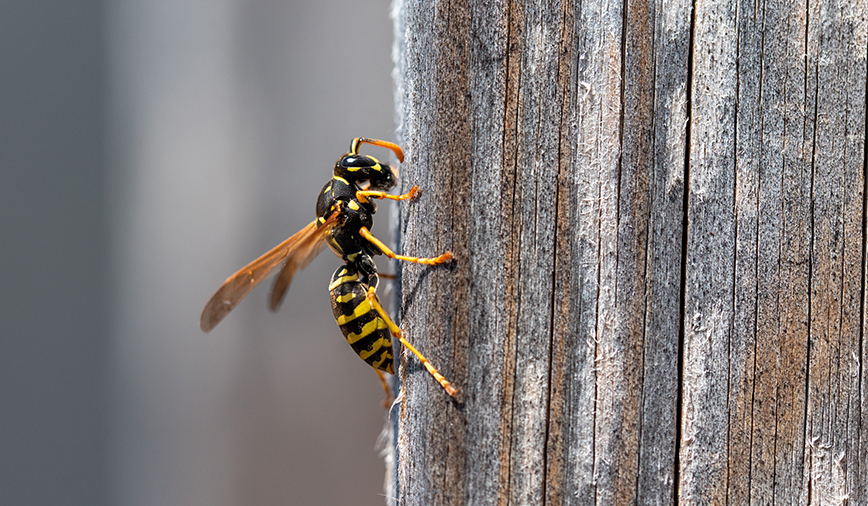Farmers—those with livestock in particular—have a saying: Some days you step in it, some days you don’t.
Today, as summer wanes, I’d like you all to remember that phrase and take it to heart. Because there’s a seasonal form of unpleasantness out there, and the last thing I’d want to hear is that someone has stepped in it—well, on it, actually—and is now in a world of hurt.
The “it,” in this case, is the underground nest of yellowjacket wasps.
Although yellowjacket colonies sometimes develop in attics or between exterior and interior walls of homes, and occasionally in hollow logs and trees, most of the time these social insects build their empires in abandoned rodent burrows and empty root channels. If you accidentally step on or otherwise disturb them, you’re going to get stung. No doubt about it.
Yellowjackets fearlessly defend themselves and their colony with painful stings powered by a combination of peptides and enzymes that pack a powerful punch. It’s a pop that, oftentimes, seems to come out of nowhere.
Their numbers start small. As springtime’s warmth creeps into leaf litter and fallen logs, new yellowjacket queens awake from their long winter’s nap—also known as diapause, the insect equivalent of hibernation. Having mated the previous fall, these fertile females emerge ready to start the year’s new colonies.
Each queen seeks out what she deems a suitable cavity and goes right to work, creating a small paper nest with just a few hexagonal cells. She deposits one egg in each cell, then sets about the task of raising her brood. Fed a protein-rich diet of masticated insects*, the larvae grow quickly and soon become the first of thousands of sterile females, also known as workers, that will keep the society flourishing until the first heavy frost sets in.
(*You read that right! Despite wasps’ reputation as reviled bearers of stingers and venom, these insects provide a valuable service. They help control populations of insects like flies that can become troublesome in their own right. This predatory nature is one of several characteristics that differentiate wasps from bees, the insects with which they are often confused.)
Because the colony grows gradually, it can be easy to overlook. I remember several years ago having a yellowjacket colony develop right outside my front door, in an old chipmunk hole. I saw occasional wasps throughout the summer but it wasn’t until late August that I noticed steady traffic concentrated in one area. I looked a little closer and, sure enough, German yellowjackets had made themselves at home, at my home.
These imports, Vespula germanica, are the nonnative representative among the handful of vespid species that can occur in our area. They first appeared in the U.S. in the 1970s, on the East Coast. Some accounts state that they were stowaways in shipments of lumber. Regardless of how they got here, they have spent the ensuing decades spreading throughout the country, aggressively commandeering territory and displacing native species as they go.
So the other day it was with some surprise—a tiny bit of delight, actually—that I realized a colony of yellowjackets I’ve been keeping an eye on actually are not the pervasive V. germanica. Rather, they’re V. maculifrons, the eastern yellowjacket.
Do these gals defend their colony? Yes. Can they sting? You betcha. But they’re part of our native ecology. They might be ornery, but as we alluded to earlier, they’re also programmed to capture maggots, grubs and caterpillars—many of which will overpopulate if left controlled.
This time of year, though, yellowjacket queens are aging. Larvae production is on the wane and demand for insects is down. Worker wasps still have to eat, though, and new queens need to pack on the fat reserves needed to survive the cold weather months. As a result, sugary foods—anything from plant nectars and fermenting fruits to pop and beer—are in high demand. Which means the risk of stings goes up.
This year, the chances of getting stung are even higher. Thanks to a mild winter, which resulted in high rate of queen survival, and a wet spring and summer, yellowjackets right now are everywhere.
Should you, during your outdoor ramblings, happen to notice a lot of flying insects in a certain area, pay close attention. It could be something as innocuous as flies visiting a pile of you-know-what—material you don’t want to step in but can endure even if you do.
If however, on closer inspection, you see that the insects are boldly striped, and flying in and out of a hole in the ground, take special care. You’ve found a yellowjacket nest.
Steer clear! This time of year the colony will contain thousands of individuals, many of which will mobilize at the merest hint of a threat.
If the nest is on your property and you want it removed, call a professional. If you don’t want it removed—remember, the colony’s old queen and her many loyal workers will all die come winter–that’s fine too. Just be sure to remember where the entrance to the nest is. Don’t step in it, on it or anywhere near it.
Pam Otto is the manager of nature programs and interpretive services at the Hickory Knolls Discovery Center, a facility of the St. Charles Park District. She can be reached at 630-513-4346 or potto@stcparks.org.

